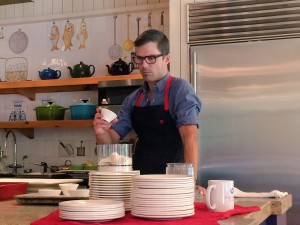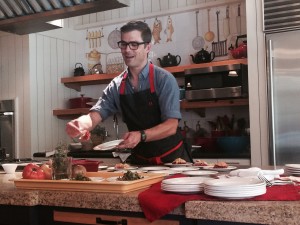10 Things We Learned from Hugh Acheson
/ You won't believe Hugh Acheson's strategy for making crème fraîche. He combines buttermilk and heavy cream, covers the mixture with plastic wrap, and lets it sit above the fridge where the temperature tends to be 80 degrees. After 24-36 hours, the mixture should have thickened up and developed the bacterial cultures that make it so tasty.
You won't believe Hugh Acheson's strategy for making crème fraîche. He combines buttermilk and heavy cream, covers the mixture with plastic wrap, and lets it sit above the fridge where the temperature tends to be 80 degrees. After 24-36 hours, the mixture should have thickened up and developed the bacterial cultures that make it so tasty.
This is just one tip we learned from the celebrity chef with restaurants in Athens and Atlanta, Georgia. You also know him from countless appearances on Top Chef as a judge. What you may not know, is that Acheson makes his way to DC quite often because of his passionate work in food policy. Specifically, Acheson tells us he is working on a a new initiative to rework home economics curriculum to be more current. He shared that on recent visits he dined (and loved) Rose's Luxury, Toki Underground and Zaytinya.
We joined Acheson's cooking class at Lake Austin Spa Resort on June 18. An intimate group of spa-goers learned to make three recipes from Acheson's new cookbook, The Broad Fork: Tomato salad with crisped farrow, purslane, arugula, and roasted tomato-miso vinaigrette; pan-roasted chicken breasts with creamed corn, lemongrass and crisp shallots; and raspberry cobbler with drop biscuit topping. The goal of the vegetable-forward cookbook is to help home cooks not waste anything in their CSA baskets and gain more confidence in the kitchen.
In addition to a unique approach to making crème fraîche, we also picked up the following pointers:
1. It's important to let meat rest before you serve it because it allows the liquids that have retreated to the center to "repopulate" all areas of the protein before serving it. When resting meat, Acheson says it's best to use a grooved cutting board.
2. Don't be afraid to add fresh herbs to finish off a dish, that includes dessert. Basil in particular goes well with berries.
3. When buying arugula, avoid the kind with the jagged edges because that tends to be a sign the lettuce variety is mass-produced. Head to the farmer's market to look for smooth-edged arugula, which Acheson calls rocket.
4. Fermented foods are your friend. Acheson says it's a very good thing that Americans are becoming more adventurous when it comes to trying foods with the right kind of rot. The miso in his tomato-miso vinaigrette is a good example.
5. Everyone should know how to make a basic vinaigrette. Mix together three parts oil and one part acid and then add anything you please. He recommends putting dill pickles through the food processor and adding the result to the oil and vinegar mixture.
6. Home cooks should have at least two levels of olive oil: a refined $20 olive oil for finishing dishes or using in salad dressing and a $9 or $10 bottle for cooking that should still be extra virgin.
7. Don't be afraid to cook chicken slowly. Acheson says we have a tendency of want to cook chicken as quickly as possible. For best results, make sure a chicken breast is salted and dry before it hints the pan, fatty skin side down. Allow it to cook there (on medium heat instead of high) for as long as possible before letting the other side kiss the pan.
8. Before you get started, read a recipe all the way through! Then get organized, pre-measuring ingredients so yo can really move.
9. Every time you cook, you should extract one major skill that can become a foundational block of your cooking abilities. Once you've followed the recipe to learn how to properly cook farro, for example, don't be timid about adding to a recipe using what's in your fridge.
Check the Lake Austin Spa Resort website frequently because they hold "Culinary Experience" weeks quite often, and bring in top talent. In August, for example, Acheson's Top Chef judging colleague, Gail Simmons, will be at the resort leading cooking sessions (August 15-16).
Culinary Experiences at the resort are a great way to get face time with movers and shakers changing the face of food today. Just be careful because they often stay at the resort, meaning you could end up huffing and puffing next to someone like Acheson on the treadmill.
Laura Hayes is a frequent contributor to Edible DC. She is a DC-based food writer and photographer who also contributes to Thrillist, Arlington Magazine and Washington City Paper.





